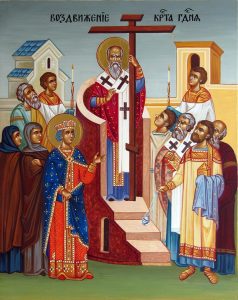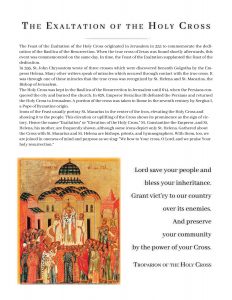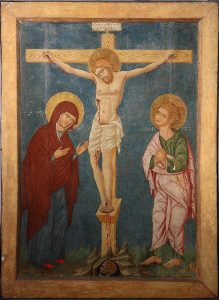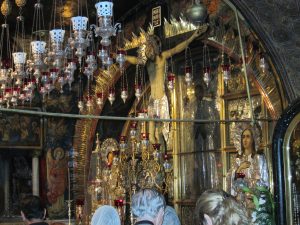This online lecture, “The Incarnation and the Cross: Understanding Christ’s Redemptive Act,” is recommended for your adult formation in the faith.
The online lecture is free but you have to register.
For information and to register, visit this link.
This online lecture, “The Incarnation and the Cross: Understanding Christ’s Redemptive Act,” is recommended for your adult formation in the faith.
The online lecture is free but you have to register.
For information and to register, visit this link.
On this the Third Sunday of the Great Fast, St. Michael’s faithful honored and venerated the Holy and Life giving Cross of Our Lord and Savior Jesus Christ. At the Divine Liturgy, we venerated the Cross as we arrived at Mid-Lent.
Fr. Iura reminded us in homily that we must, as the Lord has authoritatively taught, take up our cross. The cross is THE path to salvation.
According to the Synaxarion, the feast celebrates the veneration of the Holy Cross in Constantinople. The early days of August were dangerous in antiquity. Because of the heat, many diseases became strong, and so the Cross was displayed in various places in the city for fourteen days. This feast was then introduced into Rus in the fifteenth century.
Today it announces the coming of the great feast of the Exaltation of the Holy Cross on September 14, approximately forty days from now. I think in may ways we misunderstand the Cross, we equate it with pain and suffering, as a negative sign that Christians were made to be miserable. That is not what St. Paul says in today’s epistle, “The message of the cross is foolishness to those who are perishing, but to us who are being saved it is the power of God …. The message of the cross is foolishness to those who are perishing, but to us who are being saved it is the power of God” (1 Corinthians 18:18.23-24).
St. John calls the Cross the glory of Jesus, not because of its ugliness, but because it witnesses to the infinite love of God for his people. Because of love the cross is a “trophy of victory.”
In the Ambon Prayer of the Feast of the Exaltation, we pray, “You are glorified by the exaltation of your venerable Cross and by it accomplish our purification from the pride of demons.” As the people of Constantinople centuries ago looked to the Cross for deliverance from illness, we look at it today as our hope for deliverance from sin and evil.
Meditation by Archpriest David Petras
Often we make the Sign of the Cross without thinking of the meaning of this gesture. It is easy to forget; hopefully it is easy to get back to the center, too. In the days following the Sunday of the Veneration of the Holy Cross, perhaps we can stop to think and “feel” our making the Sign of the Cross with love and appreciation for what Jesus did (and does) for us. St. Cyril of Jerusalem calls the Sign of the Cross the seal.
Many thanks to Carrie Chuff for the wonderful illustration of how we make the Sign of the Cross!
Thanks to God With Us Online.
Today in the Byzantine Catholic Church it is the Sunday of the Holy Cross. It is a day on which we recall that wood heals wood, the wood of the cross heals the wood that tree in paradise we were told not to eat from. Today we venerate the Holy Cross and it signals mid-Lent. As members of the Order of the Holy Sepulchre of Jerusalem we are keenly aware that the cross is intimately connected with the Lord’s victory over death, and thus our salvation.
St John Chrysostom teaches us:
“Therefore, no one should be ashamed of the venerable symbols of our salvation: of the cross, which is the summit of our goods, for which we live and are what we are. Instead, let’s carry the cross of Christ like a trophy everywhere! All things, among us, reach their fulfillment by means of the cross. When we have to be reborn, the cross becomes present; when we feed on the mystical food; when we are consecrated ministers of the altar; when other mysteries are fulfilled, this symbol of victory is always present there.”
Homily on Matthew 54, 551B-552A.
When, then, you make the sign of the cross on the forehead, arm yourself with a saintly boldness, and reinstall your soul in its old liberty; for you are not ignorant that the cross is a prize beyond all price.
Consider what is the price given for your ransom, and you will never more be slave to any man on earth. This reward and ransom is the cross. You should not then, carelessly make the sign on the forehead, but you should impress it on your heart with the love of a fervent faith. Nothing impure will dare to disturb you on seeing the weapon, which overcomes all things. (St. John Chrysostom)
As we approach the Sunday of the Veneration of the Holy Cross, let us consider also how we reverence the cross in our day to day life. Do I make the Sign of the Cross impressed on my heart with fervent faith?
Here are the Biblical, liturgical and catechetical resources for this Sunday given to us from God With Us Online. Be sure to both the Troparion in the Ukrainian tone and the Gospel reflection.
 Read: Galatians 2:16-20; Mark 8:34-9:1
Read: Galatians 2:16-20; Mark 8:34-9:1
The first sticheron of the Feast of the Holy Cross tells us, “By this Cross …. In his mercy (Christ) clothed us with beauty and made us worthy of heaven.” This is confirmed in the Hymn of Light from Matins: “The Cross is the beauty of the Church.” How can this be? For the Cross is ugly torture, and the Prophet Isaiah foretells of the Messiah:
“See, my servant shall prosper, he shall be raised high and greatly exalted. Even as many were amazed at him— so marred were his features, beyond that of mortals his appearance, beyond that of human beings. He had no majestic bearing to catch our eye, no beauty to draw us to him. He was spurned and avoided by men, a man of suffering, knowing pain, like one from whom you turn your face, spurned, and we held him in no esteem” (Isaiah 52:13-14; 53:2-3).
One is reminded of St. Paul, “For you know the gracious act of our Lord Jesus Christ, that for your sake he became poor although he was rich, so that by his poverty you might become rich” (2 Corinthians 8:9). We might re-phrase: “In his ugliness, we have all been made beautiful.”
Where is the beauty of the Cross? It is in the holiness of Jesus, who died that the Kingdom of God – life, love, mercy, wisdom – might be established in the world. We are called to “take up the cross,” which means uniting ourselves with Christ in love that the truth and wisdom and the glory of God might shine forth. Today, therefore, St. Paul writes, “I have been crucified with Christ; yet I live, no longer I, but Christ lives in me; insofar as I now live in the flesh, I live by faith in the Son of God who has loved me and given himself up for me” (Galatians 2:19-20).
Meditation by Archpriest David Petras

courtesy of the Melkite Eparchy of Newton
 “… let us venerate the wood of Your cross, O friend of men, because on it You have been nailed, Life of all. You opened heaven, O Savior, to the thief who had faith in You; he was worthy of bliss because he confessed to You: remember me, Lord… we have all sinned, for Your love compassion do not despise us.”
“… let us venerate the wood of Your cross, O friend of men, because on it You have been nailed, Life of all. You opened heaven, O Savior, to the thief who had faith in You; he was worthy of bliss because he confessed to You: remember me, Lord… we have all sinned, for Your love compassion do not despise us.”
Today we sing, We bow to your Cross, O Lord, and we glorify your holy resurrection!!!
Image: Crucifixion scene from the post Byzantine era of the mid-15th century, at the church museum of Rossáno, Calabria.
 Today’s meditation is done by Sr. Vassa Larin
Today’s meditation is done by Sr. Vassa Larin
“Then Moses led Israel onward from the Red Sea, and they went into the wilderness of Shur; they went three days in the wilderness and found no water. When they came to Marah, they could not drink the water of Marah because it was bitter; therefore it was named Marah. And the people murmured against Moses, saying, ‘What shall we drink?’ And he cried to the Lord; and the Lord showed him a tree, and he threw it into the water, and the water became sweet.” (Ex 15: 22-25a)
This passage is from the first reading at Vespers on the great feast of the Exaltation of the Cross, celebrated this Thursday (NC). What does this passage have to do with the feast? The “tree” that Moses throws into bitter water, and that makes the water sweet, is traditionally seen as an image of the “life-giving” Cross.
Water itself, essential for our biological life, is an image of life. But our life, in merely biological terms, devoid of Christ and His cross-carrying journey, can be bitter. The small and great pains through which we inevitably journey, as we transition from one life-situation to another, can be pure bitterness for us, outside of the Cross. Because from a Christ-less, Cross-less perspective, they are meaningless. And meaninglessness, as Carl Jung noted, is one of the biggest traumas of the modern-day psyche: Today we tend to fear, said Jung, that our lives are meaningless.
But in light of the com-passionate, co-suffering with us of the God-Man, Who walked through all our suffering and darkness, even unto death on a cross and descent into our hell, we are given new meaning and new purpose in our New Companion, our primary cross-carrier and Lord Jesus Christ, Who brings us new life through His death. Admittedly, He doesn’t explain to us the “meaning” of all our suffering. Instead He, Who is the eternal Logos, Meaning itself, takes on, in our shoes, all our darkness and suffering, by walking through it in His humanity, and then overcomes it in His divinity, trampling death “by death.” In communion with Him, we go forward His way, of walking through things, according to our responsibilities, rather than avoiding them. And then He does the rest, by His grace, overcoming in us our merely-human anxieties and discouragement, into which we easily slip when on our own, in self-reliance, trying to carry all the ups and downs of the world on our own shoulders. In Him, I discover the “ease” and “light” of His Way, if I just try it; if I try His “how,” rather than ask my “why,” and connect with Him today. “Come to me, all who labor and are heavy laden,” He says to me today, “and I will give you rest. Take my yoke upon you, and learn from me; for I am meek and humble in heart, and you will find rest for your souls. For my yoke is easy, and my burden is light.” (Mt 11: 28-30) So let me try Him today, and find rest for my soul.